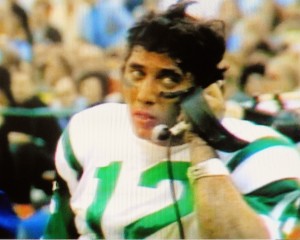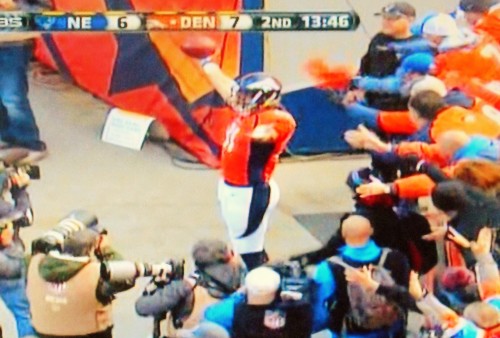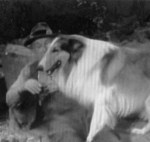
There’s Curt Gowdy, NBC’s main play-by-play man. Dressed in bright green sport coat, he’s superimposed over a live image of a packed Orange Bowl Stadium pre-kickoff crowd. All that, scrunched within the square aspect ratio TV screen. On the field, helmets look a little square, too; same for the huge shoulder pads. Even the head coaches are square – or dapper – both dressed in ties.
Forty-man rosters stand compactly within a twenty-five yard space along their respective sidelines. Just beside both, photographers and spindly, tie-clad policeman linger only a yard behind the out-of-bounds line; beyond them, the lonely cloth goal line flag flapping in the Miami breeze. It’s January 12, 1969. The upstart NY Jets are playing the mighty Baltimore Colts in Super Bowl III.
Jets’ Bake Turner, a straight-on kicker, boots the ball and Super Bowl III is off and running. And running. So many running plays. After just a couple of series, millions of viewers already know play is tough, players are gritty but the completion is clean. Bodies are tackled, not heads, nor footballs to strip them free.
In their high tech production, NBC is using the miracle of instant replay, reserved mostly for pass play reviews. There’s close-up camera work, too, although used far too amply for the face and bodies of referees. NBC’s picture quality is state of the art, but is still rather fuzzy. For example, it’s difficult to count the number of face bars on player’s helmets. Is it true the punters and safeties have only one face bar? But the on-screen graphics are fairly tight, with streamlined, typewriter-like all cap white letters superimposed over images.
Colts’ Tom Mitchell dives for an errant throw. Laid out in prone position, he’s saved injury by Jets safety Johnny Sample who holds back from landing on him. Such grace under pressure.
Sublime is Joe Namath’s flick of the arm that tosses a perfect spiral fifty-five yards downfield. An incomplete pass, all players hustle back to the line of scrimmage. There are no player substitutions. There are practically no shifts at the line of scrimmage. If anyone is subbed, it’s done during time outs or commercial breaks, of which there are very few.
Super Bowl III has evolved into a defensive clash with the Jets leading 10-0 in the third quarter. Namath looks conspicuous on the sideline, the only player with his helmet off. How strange no one else utilizes this opportunity for valued face time. He’s so talented and so cool. Joe Willy has become my idol. But he trots off the field a series later, favoring an injured throwing hand. No one, even a trainer, comes over to look at it. Heroically, Joe Namath comes back in, pain and all.

Colts’ Jerry Hill scores a touchdown with three minutes to go. With the score 16-7, Baltimore goes for an on-side kick. They get it, but safety Rick Volk is dazed, unable to get off the field. Thirty million viewers watch four Colts drag him to the sideline. Even the great Johnny Unitas, replacing ineffective Earl Morrall, can’t perform magic and the Colts, eighteen point favorites, lose, 16-7. In a landmark sports event, the AFL (now the AFC conference) has caught up with the once far superior NFL teams in talent.
~
January 24, 2016. It’s the AFC Championship game between the New England Patriots and Denver Broncos, with today’s AFC winner going to Super Bowl 50. Invesco Field, seen with gigantic Jumbotron on one end, military units the other, is being presented by CBS in HD Cinemascope-like scale, including scintillating graphics to expand the viewer experience (all this just for coverage of the national anthem).
New England’s opening series is three and out. The two pass plays are reviewed by five replays; there are none for the boring run. After the punt, four commercials follow, their combined real-time exceeding the game clock time for the entirety of New England’s initial possession (1:58).
Denver’s first drive includes fancy on-screen team statistical comparisons, a close-up revealing one eyelash missing from Peyton Manning’s right eye, shots of both coaching staffs dressed in casual sweat suits, and – oh, yes – a passing touchdown culminated by the receiver celebrating near the stands. The subsequent extra point is overshadowed by four more commercials.
After Denver’s kickoff, the game is stopped again for four more commercials, including one with Peyton Manning singing and selling insurance. New England suffers another three and out, their possession highlighted by player’s constant bickering over pass interference. After their punt, four commercials follow, including one touting player character and what NFL warriors are doing for underprivileged kids in their communities.
Just before the first quarter ends, New England scores, making the score 7-6. Add also nine more commercials, a three-minute and ten second coach’s challenge, an on-field interview, two ugly personal foul calls, another TD celebration (a demonstrative Rocky-like pose for fans), a missed extra point, 76 total player substitutions (just a guess), and an awesome plastic pylon cam shot of the touchdown.

What the next three quarters reveal is one very great game. Competitive, exciting, and well-played, one in which Denver prevails, 20-18, demonstrating yet again – much like Super Bowl III – that hard nose defenses win championships.
But these last three quarters also provide great insight on modern NFL football.
There are many sideline reports interspersing – or interrupting – the game with in-the-moment media information: a player “has just passed the league’s concussion protocol,” “…tablets on the New England sideline are okay to use now,” a reporter’s views on the kicker’s specific thought process and physical protocol preparing for the upcoming kick, and even a shot of Rob Gronkowski lying flat on his back, oxygen mask over mouth, receiving massive leg massages on the sideline.
Perhaps the game no longer needs referees. All game long, Patriot and Bronco players are most adept at gesturing what should be called, among their specialties fumble recoveries, out-of-bounds calls, touchdowns, first downs, and incomplete passes (their favorite). Regular gesticulations to the crowd about just how great they are is another forte players possess. Seizing camera time, but in this far more grandiose manner, is where we’ve come from Namath’s seemingly harmless quest for attention removing his helmet on the sidelines many years ago.
Since referees fail to impede player’s constant pushing and shoving of opposing team members (even the kickers!), do we really need the zebras? Then again, if players are so smart, why were the majority of penalties for brainless false starts, unnecessary misconducts, and pass interference calls? It’s interesting to note the championship game had 14 combined penalties for 104 yards while Super Bowl III saw a total of three yellow flags.
Gang tackling by speedy, yet heavy-muscled players reveals a game far more brutal than pioneer Super Bowl contests. Today, offensive tackles average a height of 6’6” while nose tackles average 322 pounds. The median player weight of the Super Bowl III teams was 229, whereas the 2015 Indianapolis Colts squad averaged 256, a 27 pound increase in muscle, strength and power. This, combined with speed, make collisions frightening, yet hard hits are what make fans and defensive backs salivate.
Perhaps the heaviest weight put upon the modern game is commercials. One hundred and five thirty-second commercials were broadcast during the Patriots-Broncos game (not including halftime). That’s 52:30 in real-time of a game that’s 60:00 long. No wonder it took three hours and thirty minutes to complete this contest, keeping in mind most commercials interrupt play: players wait while television viewers are sold cars.
Maybe it was Curt Gowdy’s soothing voice that made Super Bowl III such a great game for me to watch. Or is it my inner voice, one continually tapping my shoulder from some distant, foggy time, that constantly reminds me of the once simple, swift and comparatively innocent NFL game I remember from 43 Super Bowls ago.


























